by successfulbob | photography creativity, photography education, success education
It’s interesting the turn my career has taken over the years. Commercial photographer, wedding photographer, portrait photographer, educator and writer. I’ve worked through many genres of photography and now concentrate on creating art, commercial imaging and education/writing.
Current writing ASP and The Photographer Magazines
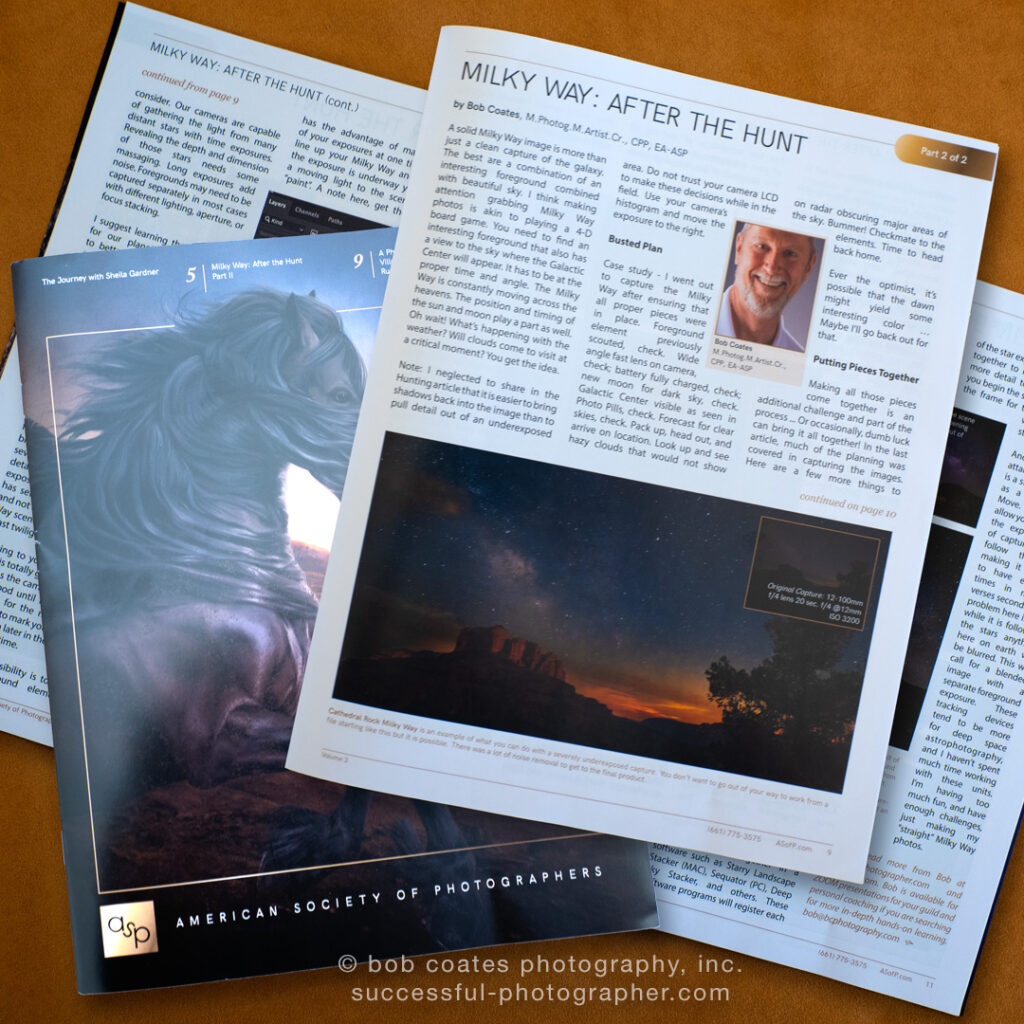
Article in the Fall Issue of ASP Magazine
Here is are a couple magazine articles I’ve penned and had published recently. One is for American Society of Photographers (ASP). It was a follow-up to my photographing the Milky way article. This was on processing to take the images to the next level. Look for the Summer issue for planning and shooting. Fall issue was on post-production of Milky Way images. The camera, lens and long exposure collect way more information than your eye can see. Post processing reveals all the color and grandeur of the Milky Way.
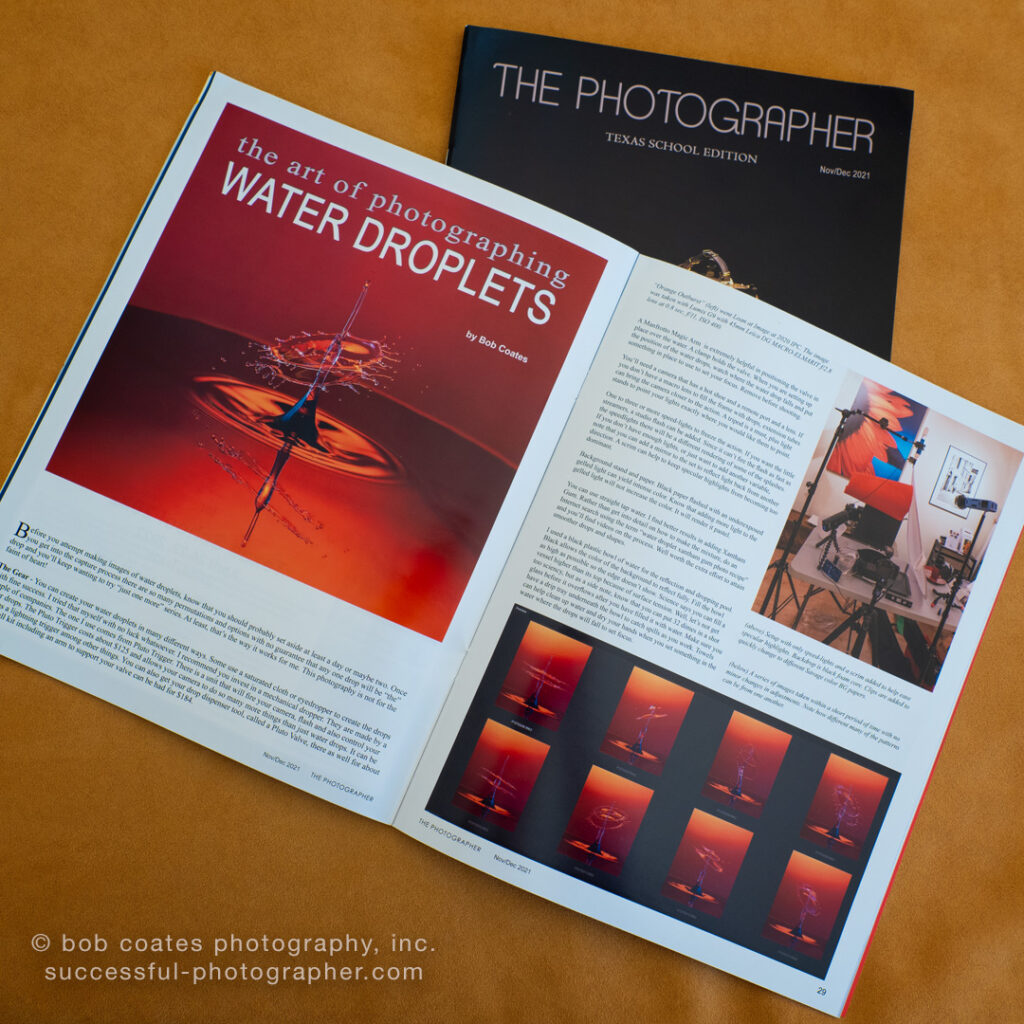
Article in the latest issue of The Photographer Magazine
The other magazine article that just dropped was for ‘The Photographer’ magazine. It shares ideas on capturing water droplets in and artistic and colorful fashion. The Art of Photographing Water Droplets can be accessed and read here.
Photofocus online
Photofocus is an online magazine for which I write at least three articles a month, often more, for the last three years. This is in addition to writing for Successful-Photographer. Here are a couple links to the last articles I posted.
If you are looking to sell your work online here is a possible solution for you. Getting your art found on Fine Art America.
This is an article on post-processing images with beauty retouching for hotel properties. Developing high-end hotel property photography.
Photography career
Weirdly enough all of my photography career has been some combination of photography, education including hands on and presentation to photography groups and writing about it. If you need a speaker, writer, photographer or Lens Based Artist, let me know!
Yours in Creative Photography, Bob
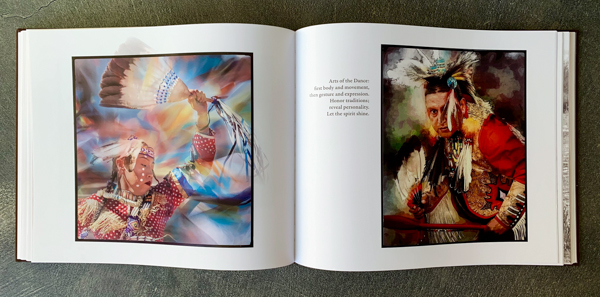
by successfulbob | art books, Guest Post, inspiration, marketing, photography education, photography marketing, success education
Fellow photographer Sara Francis has published photo books and asked to share the trials and tribulations of getting them into print. Please welcome Sara with these guest posts as she shares this five-part series on getting a photo book into print.
Your Photographic Forever; a five-part series that will make you want to put your images into print. Why Print a photo book now?
In spite of distancing and upheaval, it’s a great time to publish a photo book—your photographic art in book form. My personal experience on the road to publish my retrospective and photo-memoir kickstarts this series. Here’s the good news.
All book sales, including art and photo books, are up more than 100%. As photographers, we already own and work with many of the tools needed to conceive and design an attractive, salable book—without paying for costly designers and editors. Printing costs are now much less than you’d expect.
The concept of a book, a stunning, coffee table book, hard cover, with a wide-ranging folio of our own work, well, that’s a goal that most of us have fostered for some time. I tried all sorts of avenues, including university presses for my 60-year photo project and memoir of the Taos Native American Pueblo, the artists of Taos I have known and the wonder of the region. Yes, strong regional interest and potential audience. I discovered four major roadblocks.
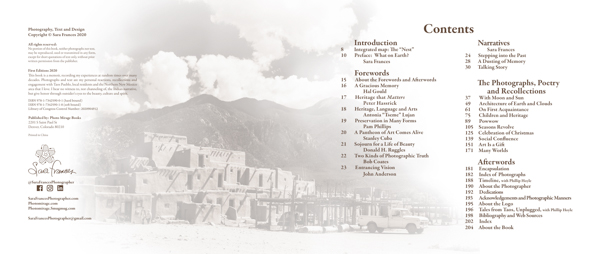
A great title, and also an informative, attractive contents page must grab attention. Note that most books are filed with only the spine showing, so be sure to have title, author and publisher name or mark showing.
Choose your publisher
Institutional presses, if they accept you at all, take at least two years to come to print, and you have little say in the design and presentation. Exclusively photo and art book printers have limited funds and take a handful of projects a year. Many say they approach only photographers they themselves name. No chance to submit. More mainstream publishers are so genre-conscious that images, especially images with text or poetry are simply not a fit they consider. Worse, publishers who claim support for new or regional artists mostly just want to sell you their design and editing services, so you still have little input.
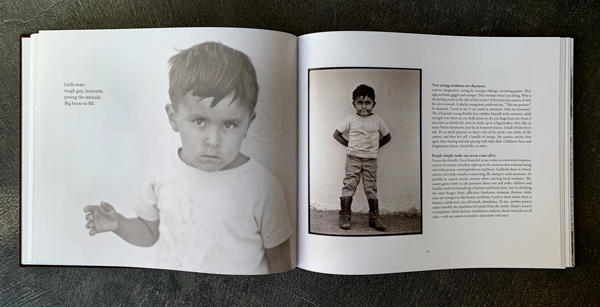
Image and text, both poetry and memoir, tell the story of why I photographed this child.
This the bad news I encountered, and it was a deal breaker. I’ve spent more than three years figuring out how to do it myself, my way. I set out to work through the entire process from concept to design to print to distribute and promote. I wanted my book to look just like I wanted, not someone else’s design. At this point I can give you more good news. Over 50% of all books published are now independently or self published. And this trend continues to increase.

Ceremonial color proves a good foil for the sepia duo-tones in telling the regional story.
Steps forward
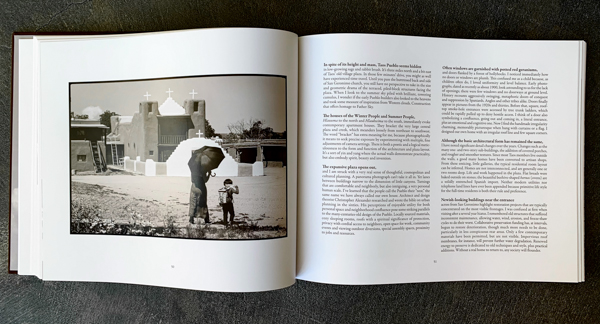
Classic rule of thirds composition in a grab shot, again unfolds the story.
Here’s the breakdown of steps to make the process financially feasible and technically manageable. In this series I hope I can coach you to think seriously about publishing and start the process toward reward under you own hand.
Concept
Audience
Content
Printer choice
Design
Edit
Warehouse
Distribution
Promotion
Bob is the first one to tell you that you don’t get rich on a book. My job is to show you steps to publish that won’t break the bank. And the riches! The satisfaction of a beautiful book is worth everything.
Proceed to Part Two of your book publishing path.
Sara Frances
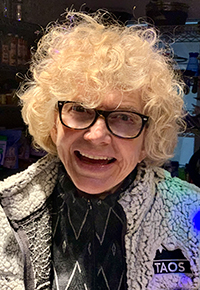 Sara is a many-decades Master Photographic Craftsman out of Denver whose artistic focus has always been book making with images. Her albums won PPA merits starting well before digital capture, as well as for what is believed to be the first ever awarded portrait album. She has evolved from daily, shorter-term studio photography into exclusively special projects of long commitment. Her second hybrid photo/memoir art book, Fragments of Spirit, now published under her own mark, Photo Mirage Books, is available mid-December 2020.
Sara is a many-decades Master Photographic Craftsman out of Denver whose artistic focus has always been book making with images. Her albums won PPA merits starting well before digital capture, as well as for what is believed to be the first ever awarded portrait album. She has evolved from daily, shorter-term studio photography into exclusively special projects of long commitment. Her second hybrid photo/memoir art book, Fragments of Spirit, now published under her own mark, Photo Mirage Books, is available mid-December 2020.
Renewing her lifelong interest in creative writing, she was recently was accepted for Lighthouse Writers Workshop’s Poetry Collective, graduating a year later with a forthcoming hybrid work marrying over 275 manipulated iPhone images with 120 poems: What to Wear to Paradise.
Her three-year quest to learn all facets of the art book industry has influenced her to give back with hands-on publishing classes. She is a judge for the Independent Book Publishers Association (IBPA) and for Colorado Independent Publishers Association (CIPA.) She teaches for Osher Lifelong Learning Institute (OLLI) at the University of Denver, for PPA Super One Day seminars, and also mentors hybrid image/text projects.
To find Sara on social media search SaraFrancesPhotographer or email – [email protected]

by successfulbob | Guest Post, Marketing Monday, photography, success education
Portrait Pricing Guidelines with Steve Bedell – Part Three
Steve Bedell shares his thoughts on Portrait Pricing.
“As I reviewed my part 1 and part 2 of this pricing topic here on Successful-Photographer I was astounded that having so much knowledge I wasn’t worth about 27 million dollars! In any case, there was great response to the article about pricing in general and how to determine where you should be in it so now we continue with specifics.
Please note that much of this is my opinion but a great deal of it is what I’ve learned by PSTM (people smarter than me) so I stray from these guidelines at your own risk. With that in mind, let’s get going. Again, my mind kinda wanders all over the place so things may not be in proper order, but put up with me, the info is the same.
 ONE: Should I have a printed price list?
OK, I’m not kidding here. I see in online groups people asking for all kinds of feedback on their price list. NOT the pricing, but how the price list looks. They’ll discuss fonts, layout, etc. They’ll look nice and pretty but does it really matter? We’ll come back to that but question two is related so let’s get to that right now.
ONE: Should I have a printed price list?
OK, I’m not kidding here. I see in online groups people asking for all kinds of feedback on their price list. NOT the pricing, but how the price list looks. They’ll discuss fonts, layout, etc. They’ll look nice and pretty but does it really matter? We’ll come back to that but question two is related so let’s get to that right now.
TWO: Should I post prices online?
This one is MUCH easier to answer: NO!
Why? Because if someone goes online looking for a photographer and does a Google search and they see your 8×10 (the standard that they all know) is $195 and Joe’sSuckyPhotos.com is $29, which one will they choose? They’ll most likely choose Joe because they are just looking at prices and when you compare pricing in a vacuum you are looking at a commodity. If they visit your site and instead see your special booklet that tells them ‘5 Tips for a Great Family Portrait’ and lots of testimonials you have already set yourself apart from the bottom feeders.
OK, so now that we have a little background, should you have a printed price list?
I say yes, so it doesn’t look like you’re just pulling prices out of the air. But do you need to print up hundreds and send/email them to everyone who contacts you?
No.
You only really need one, and that’s for you to use in the sales room. Don’t believe me? Bradford Rowley uses a SLIDE of the price list during the sales session and only leaves it there for as short as possible. You want people focused on picking the best pose and the proper size portrait, you do NOT want them sitting there with their nose in a price list.
A little caveat here. I am talking about a PRICE LIST, not a Product Guide. A product guide will show sample of the products and a starting price or price range. One of the best I’ve seen is by Megan Dipiero. We featured Megan a little while ago, you can see her guide HYPERLINK “http://files.megandipiero.com/product-guide/?page=1” \t “_blank” here.
THREE: When should I show the price list?
There are different schools of thought on this.
Some say don’t ever show it, just let them come to the order appointment, write up what they want, then tell them the price.
Others tell them pricing during the consultation when the session is booked.
I’ve used both methods, they both work. I prefer the up front method, it makes me and them more comfortable at the sales session, less like I’m holding the images hostage. Do what you’re comfortable with and what works for you. Previous to a consultation, always use a price range instead of exact pricing, like ‘Our gift prints start at $95 and wall collections begin at $1800’ or something along those lines. They’ll have a better idea of why you charge what you do during the consultation.
FOUR: Good/Better/Best pricing
This model has been around since the dinosaurs. Why? Because it works! I have my ‘paper prints at level 1, canvas prints at 2, and Gallery Wraps and metals at level 3. Decide size first, then finish. This gives you an opportunity to make more income on the same sized print. As an example, my 16×20’s are $600/$750/$925. This may seem very low to some and high to others. Also, don’t just call them finish one, two, three. Use names like The Masters, The Venetian, etc and include a descriptive paragraph like ‘enhanced by our artist and bonded to natural fiber canvas’.
FIVE: Should I have a contract?
I read many posts where photographers sound like wannabe lawyers. I like to concentrate on the experience so introducing a contract into the mix just doesn’t work for me. You should have policies for payment but in 40 years of doing this I’ve had no need for a contract. Weddings, yes, portraits, no. It’s up to you.”
More to come as Steve brings the rest of this home in Part 4 on Successful-Photographer.
Steve Bedell has been a professional photographer for over 35 years. He has done weddings, portrait and commercial work but now restricts his business to portraits only.
Steve holds the Master of Photography and Photographic Craftsman degrees from the Professional Photographers of America and is a PPA Approved Print Juror.
commercial work but now restricts his business to portraits only.
Steve holds the Master of Photography and Photographic Craftsman degrees from the Professional Photographers of America and is a PPA Approved Print Juror.
He has been named the New Hampshire Photographer of the Year a record 8 times and in 2011 was awarded the New England Photographer of the Year title. His specialty is natural light portraiture.
He has written hundreds of articles for photo publications, taught classes and workshops nationwide and produced several lighting DVDs. His private newsletter, EPhoto, reaches over 2000 photographers. Steve was a regular contributor to Shutterbug magazine.
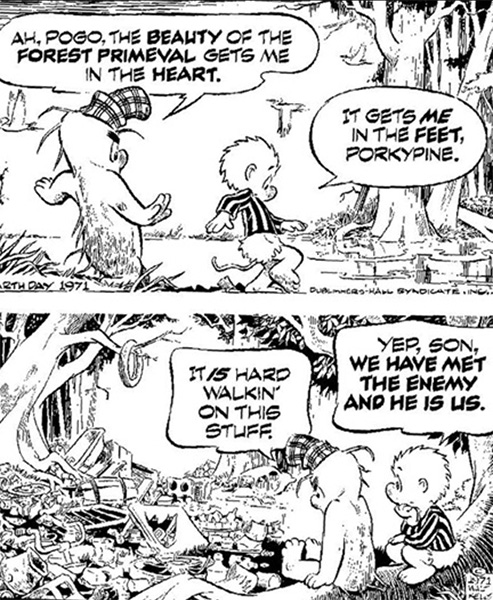
by successfulbob | photography - art quote, photography education, success education
Sunday Photo/Art Quote – Sun Tzu
Off down the road again I traipse again in this Sunday Photo/Art quote. This time, I turn to the Orient for inspiration. You wouldn’t think a guy who wrote the Art of War would be able to inspire us in our photographic art. But he can. The Art of war is traditionally ascribed to Sun Tzu. The book presents a philosophy of war for managing conflicts and winning battles.
No greater battle can there be than the ones that can rage within ourselves.
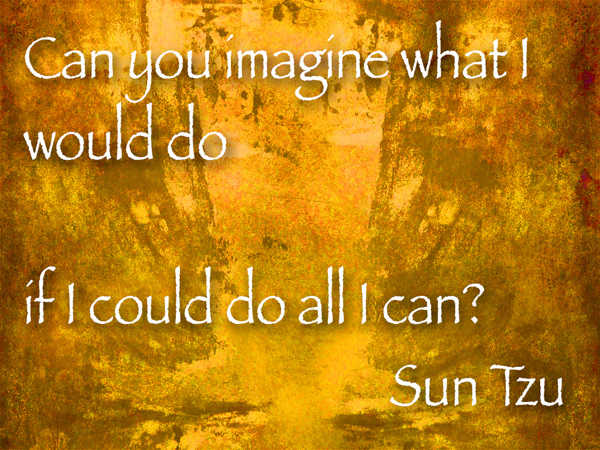 “Can you imagine what I could do if I could do all I can?” Sun Tzu
“Can you imagine what I could do if I could do all I can?” Sun Tzu
I sometimes think we hold ourselves back. At the very least I know I sometimes do. We can be our worst enemies when it comes to heading for new horizons and starting or, dare I say, conquering new projects. That little voice inside can be a help or a hindrance in our quest to create new imagery. The voice can be our best cheerleader, or it can be the little nag that is always looking for, and sharing, the worst case scenario should you start to try something that is outside your regular wheelhouse.
I’ll not go into examples here. We all have those times when we’ve been held back by our fears. And, better yet, those times we’ve placed those concerns in the closet and overridden their dire predictions and accomplished so much more than we thought possible. Let’s try to do more of the latter.
It is a constant battle. Hence why I use Sun Tzu in this thought about art and our capabilities. He was one of the greatest strategists in waging war theory that ever lived. We can learn a lot from his words.
I’ll leave you with two last quotes.
“If you know the enemy and know yourself you need not fear the results of a hundred battles.” Sun Tzu
 “We have met the enemy and he is us.” From the comic strip Pogo
“We have met the enemy and he is us.” From the comic strip Pogo
With that, I’ll see you in the battlefields of creativity.
Yours in Creative Photography, Bob
Save
Save
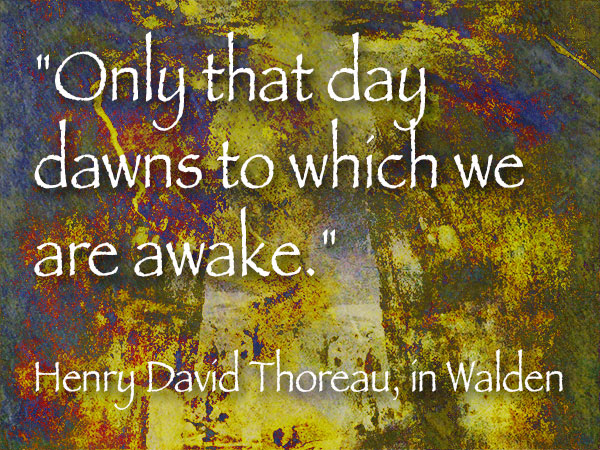
by successfulbob | inspiration, photography, photography - art quote, photography education, success education
Sunday Photo/Art Quote – Henry David Thoreau
Sometimes I head a little far afield of even the art world when I choose the quotes for this Sunday morning art thought.
Today is one of those days.
But I’ll bring it around. I promise.
Walden by Thoreau is an interesting read and his sharing of thoughts on slowing down and observing the world in which we hang out in real time and that it is a good idea. You don’t have to take as much time as he did, but you can slow down and observe for small chunks of time.
I find it quite helpful. On to today’s quote, so we are on the same page.
 “Only that day dawns to which we are awake.” Henry David Thoreau
“Only that day dawns to which we are awake.” Henry David Thoreau
I share this idea today because I find many people, including myself, often living in the past or the future instead of the present. Don’t believe me? Ever drive home and then wonder how you got there? In the shower do you feel the water cascading from your head down your body and hear the musical splashing of the drops onto the floor? Or, are you on auto-pilot missing these moments and planning what you should be doing after you get to work? Or are you wallowing in the past upset with something someone said and replaying that conversation over and over ad nauseum??
Other examples abound. Reading and not know what you’ve read moments later. Shaving your face and missing the whole left side. Brushing your teeth and not knowing whether you’ve done the top inside yet. You get the idea.
We can become better creators if we learn to be in the present and learn to observe more. See more details, Retain more of those details. For help with seeing more and recalling what you see, you might want to try Amy Herman’s book Visual Intelligence. It’s a guide to visual understanding and communicating more clearly. Her book is based on a course for law enforcement, such as the FBI, police officers and CEO’s, ER professionals to become more observant.
Getting control of our thoughts is the first step. Slowing the constant cascade of the unstructured noise that our brains are capable of generating. Meditation can be of tremendous help in quieting the mind. I recommend Jon Kabat-Zinn and his book Wherever You Go There You Are. He also has a set of guided meditations that are wonderful as you start down the road of being in the here and now. Mindfulness Meditations.
Hope you enjoy this reading list. I hadn’t intended to go this deep. Sometimes writing can lead you to a rabbit hole, and the exploration can take you to interesting places. Just ask Alice.
Yours in Creative Photography, Bob
PS – Here’s the tie in. When you see better and remember what you see you can be a better creator of images. Happy reading!
 Walden by Henry David Thoreau
Walden by Henry David Thoreau
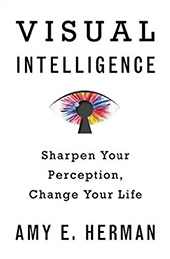 Visual Intelligence – Amy E. Herman
Visual Intelligence – Amy E. Herman
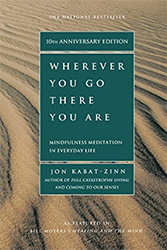 Wherever You Go There You Are – Jon Kabat-Zinn
Wherever You Go There You Are – Jon Kabat-Zinn
Save
Save
Save
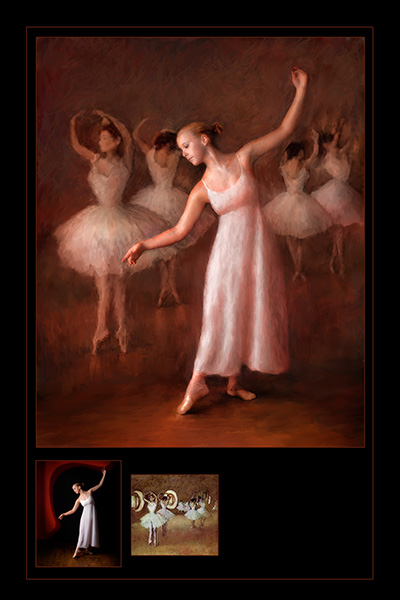
by successfulbob | photography, photography education, photography marketing, success education, tuesday painterly photo art
Tuesday Painterly Photo Art
John Chandler, CPP & Teresa Chandler
I first saw some of Chandler’s images while judging for Professional Photographers of America. I was not aware of them at the time bu the imagery stayed with me. When I saw a Facebook post, I tracked down the website and saw more interesting imagery so I asked John if he would share some thoughts and ideas on photographic art.
I turn today’s post over to the Chandlers.
The Start
John and Teresa Chandler established Chandler Studios in 2002. Their concept was to combine John’s skills in Photography with Teresa’s skills in Oil and Pastel painting. This came at the same time Photography, as a profession, was in the “Chrysalis” phase transitioning from film to digital. Their transition was not difficult. The digital revolution kicked their business forward. This is a result of John shooting transparency film underwater for 35 years. For them to get his transparencies into a print market they had to become proficient at slide scanning and preparing the image for printing in a very young, and rapidly advancing world of Photoshop. In the 90’s Teresa had the same challenge with her oil and pastel portraits. John would photograph her portraits with transparency film and she would then color-correct each scan until she was satisfied that it was a near exact copy before printing. This early experience in Photoshop, experience with transparencies and their collective ability to review, correct, prepare and produce a printed image using Photoshop prepared them well for the digital revolution. And all of this had to be done while they were living in Japan!
 “Dancing with Degas” © Teresa Chandler Accepted into the IPC 2015 Loan Collection.
“Dancing with Degas” © Teresa Chandler Accepted into the IPC 2015 Loan Collection.
In this image, Teresa took an image captured in the Studio during a High School Senior’s session. Using both Photoshop and Corel Teresa created this image. Her experience with painting in oils gives her a superior ability to “feel” light and textures needed to make an image like this. Corel gives her capacity to interpret the electronic brushes and then make the strokes necessary for the image to succeed.
The Team
John is the Photographer and Teresa is the finisher, and together they are Chandler Studios. They have been married for 39 years. John is a Certified Professional Photographer (CPP). Both are driven by the annual Print Competitions in their State Affiliate as well as the International Print Competition of PPA. Teresa has had three of her images in the PPA Loan Collection while John has only enjoyed one image in the General Collection. But both are avid competitors, and both are working toward Masters in Photography and Art.
Thoughts on progressing
Education is the KEY TO SUCCESS. This digital world is simply not something that will suddenly dawn on most people. You cannot “Fake it, till you Make it.” Anyone who wants to move forward in terms of sales, creativity and ability must take the time and resources necessary to get a first class education in Photography. We work in Portraits so most of our education comes from Photographers who are not only at the peak of their career but are also proven teachers. Passion is simply NOT ENOUGH. Passion plus education equals ability. We learned early in our careers that Passion does not make an artist. While passion may drive you (and drive you crazy) it does not give you ability. Education and the experience that comes with it will gives the ability to create the images that are driven by passion.
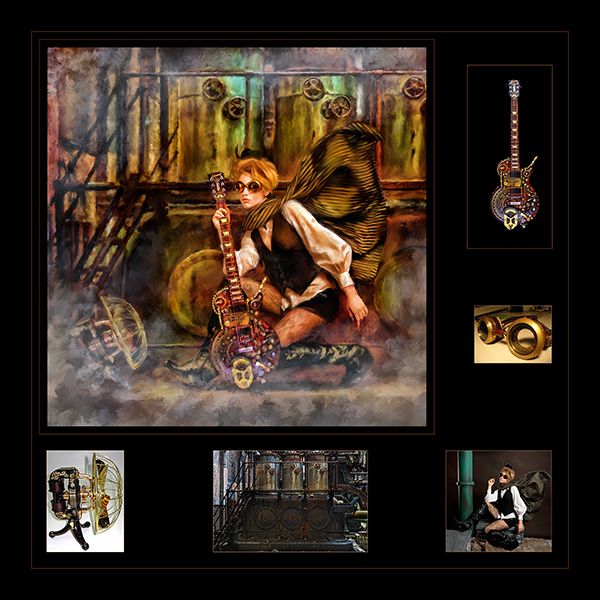 “Steampunk Rocker” © Teresa Chandler. This composite began in the Studio and then was transformed in the computer by Teresa who used Photoshop to composite and Corel to finish giving the image its texture and contrast.
“Steampunk Rocker” © Teresa Chandler. This composite began in the Studio and then was transformed in the computer by Teresa who used Photoshop to composite and Corel to finish giving the image its texture and contrast.
Mentorship
Can YouTube and Creative Live do this for you? Well, we think that videos can be an element, but not the only element. We feel you need to have “Hands On” kinetic learning to make the leaps needed to compete in today’s fast-changing market(s). Video learning combined with a mentor can be powerful tools needed to improve your ability. There are more workshops available today than ever before so that means that photographers have to choose wisely and ensure the workshop will move them forward and not just be a social event. We recommend a new photographer actively seek a mentor who can recommend workshops for them and guide them. This will certainly save that photographer a significant amount of money. We chose workshops with Joseph and Louise Simone, Richard Sturdivant, Tim Kelly, and most recently John Gladman. These workshops are not inexpensive. We consider them an investment in our Studio. We have also learned that cutting corners is just a waste of money.
Focus on your product.
Focus on what you are wanting to produce and then produce it. Practice your skills daily. If we could say that a hundred times in this short discussion we would. Practice every day! We are in the process of re-branding our efforts in Chandler Studios by developing two new products. One is called Vintage Couture that focuses on retro PINUP. This is our approach to producing a product akin to boudoir (sexy) but still something our client can show their mom!
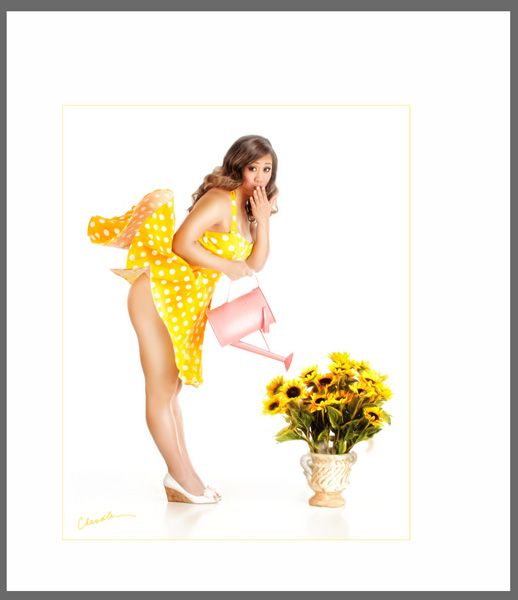 This is image was selected to be in the 2015 General Collection. This is titled simply “Oops!” It was produced for a client who loved it.
This is image was selected to be in the 2015 General Collection. This is titled simply “Oops!” It was produced for a client who loved it.
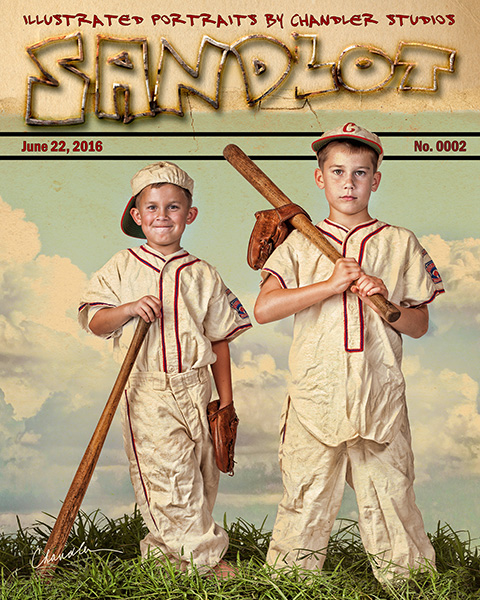 Sandlot is our most recent image and shows another product that we are producing for our clients. We call these “Illustrative” Portraits our SANDLOT collection. This product is focused on the youth sector providing our clients a retro look in the Rockwell genre. © John Chandler
Sandlot is our most recent image and shows another product that we are producing for our clients. We call these “Illustrative” Portraits our SANDLOT collection. This product is focused on the youth sector providing our clients a retro look in the Rockwell genre. © John Chandler
Conclusion
So that’s it. We have had a focus on Family Photography but we are now giving that a bit of a twist to give our products just a bit more. We firmly believe that education and professional affiliation is a path to success in this vocation we enjoy so much.
Our website is Chandler-Studios.com Our Vintage Couture can be on our website and at https://www.facebook.com/ChandlerVintagePINUP Our SANDLOT products are featured on our website and at: https://www.facebook.com/Sandlot-Portraits-1095078590564124
Hope you got as much out of the Chandlers sharing how they are pushing the digital envelope in their business as I have.
Yours in Creative Photography, Bob
Save
Save
Save
Save
























